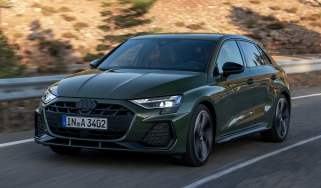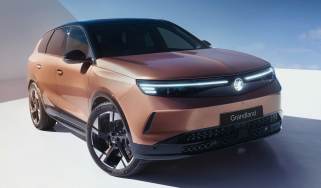London Congestion Charge: map, times, exemptions and full details
Driving into the city? Here’s everything you need to know
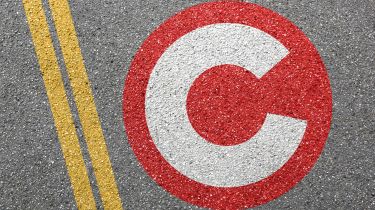
The London Congestion Charge was introduced in 2003 as a scheme to reduce traffic and the resulting air pollution in the centre of the city at peak times. If a driver wishes to enter the London Congestion Charge zone, they must pay a fee on every day they do so. There are, however, Congestion Charge discounts and exemptions for some vehicles, as well as for drivers who live within the zone or who hold a valid Blue Badge.
It’s important to note that the London Congestion Charge is separate to the London Ultra Low Emission Zone (ULEZ), with its own rules, charges and penalties. Here we explain everything you need to know about the London Congestion Charge.
Where is the Congestion Charge zone?
The London Congestion Charge zone covers eight square miles in the centre of the city, from Euston Road and Marylebone Road in the north, Tower Bridge Road and Commercial Street in the east, Elephant and Castle and New Kent Road in the south, and Park Lane and Edgware Road in the west.
The Congestion Charge scheme is enforced by Transport for London (TfL), and is separate to the ULEZ (Ultra-Low Emission Zone) which operates in a larger area. The roads within the zone are monitored by a network of ANPR cameras.
London Congestion charge zone map
Below is a map of the congestion charge zone. You can find out if a specific address is in the congestion charge zone by inputting the postcode on the TfL website.
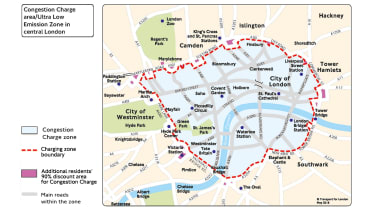
When does the Congestion Charge apply?
The London Congestion Charge applies to all vehicles that enter the zone between 7am and 6pm from Monday to Friday, and 12pm to 6pm on weekends and Bank Holidays. The charge does not apply between Christmas Day and New Year’s Day.
How much is the Congestion Charge?
Drivers must pay a £15 daily charge if they enter the zone during the times stated above. Some drivers and vehicles are eligible for exemptions or discounts, which we explain in detail further down this page.
The £15 fee applies to those who pay the charge in advance, or by midnight on the day they enter the zone. If you haven’t paid by this time, you will have until midnight on the third day after you travelled in the zone, but the fee will rise to £17.50.
Which vehicles have to pay the Congestion Charge?
If you drive a combustion-engined car - including hybrids and plug-in hybrids - you will have to pay the Congestion Charge if you drive into central London during its hours of operation.
All alternatively-fuelled vehicles used to be exempt from the Congestion Charge but, since 25 October 2021, only zero-emission vehicles - such as EVs and hydrogen fuel cell vehicles - have been exempt from the Congestion Charge. From 25 December 2025, however, even drivers of zero-emission cars will be required to pay.
How do I pay the London Congestion Charge?
If you regularly drive into central London during the Congestion Charge’s hours of operation, you can set up an Auto Pay account via TfL’s website. Using this service will also allow you to pay the Ultra-Low Emission Zone (ULEZ) charge at the same time if it’s applicable.
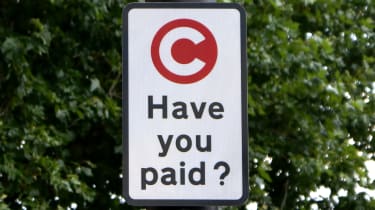
You can also manually pay the Congestion Charge on the TfL website, TfL’s official ‘Pay to drive in London’ app or over the phone by calling 0343 222 2222. There are also plenty of newsagents and petrol stations that can process payments — these shops usually have the red ‘C’ logo in the window. There are some third-party websites that claim to assist with payments, however these are not recommended due to a large number of fakes and scams.
If you’re buying a used vehicle and you want to check to see if it has outstanding Congestion Charge fines you can email TfL at OutstandingCCPenaltyCharges@TfL.gov.uk.
Am I eligible for a Congestion Charge exemption or discount?
There are a number of exemptions and discounts on the Congestion Charge that are available to a selection of different vehicles and drivers.
Residents’ discount: Those who live within the Congestion Charge Zone are eligible for a 90 per cent discount if they can provide proof of their permanent address and are on an appropriate local electoral register. Permitted vehicles can be owned, leased or company cars. Rental and car-share scheme vehicles are also allowed if they are occasionally used.
Vehicles with nine seats or more: If your vehicle has nine seats or more then it is eligible for a 100 per cent discount, but it must not be licensed for use as a bus. You will need to show TfL several documents, including the V5C vehicle log book and MoT certificate, in order to register the vehicle.
Cleaner vehicle discount: Until 25 December 2025, fully-electric and fuel cell vehicles are eligible for the cleaner vehicle discount. After this date the discount will be discontinued, but for now these vehicles don’t need to pay the Congestion Charge once they are registered with TfL. You will need to show the car’s V5C document, which must state that the car is battery or hydrogen fuel cell powered.
Blue Badge holders: Anyone who holds a Blue Badge in the European Economic Area is eligible for a 100 per cent Congestion Charge discount, even if they don’t drive or own a vehicle. Up to two vehicles can be registered for one person, provided that they are normally used by that person to travel within the zone. Along with a valid Blue Badge, one other document must be provided to prove your identity, such as a passport or recent DSS benefit entitlement letter.
Other Congestion Charge discounts: Other vehicles that are eligible for discounts include accredited breakdown vehicles, roadside recovery vehicles and motor tricycles.
Congestion Charge exemptions: Motorbikes, mopeds, tax-exempt NHS vehicles, emergency service vehicles, licenced taxis, buses, tax-exempt vehicles used by disabled people and vehicles for more than one disabled person are all eligible for exemption from the London Congestion Charge, provided they meet the necessary criteria.
What is the penalty for not paying the London Congestion Charge?
If you haven’t paid the Congestion Charge by midnight on the third day after travelling in the zone, you will receive a Penalty Charge Notice (PCN).
If you are issued a PCN, this will be for £180. However, TfL will reduce the charge to £90 if it is paid within 14 days from the date of issue. If you fail to pay or appeal the PCN within 28 days, you will then be sent a £270 Charge Certificate. If you then fail to pay the Charge Certificate within 14 days, or make a Statutory Declaration, you will be faced with an Order for Recovery.
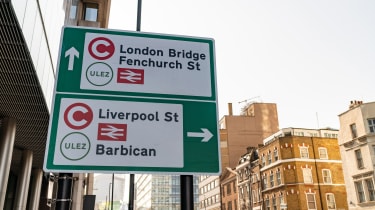
An Order for Recovery is different from a County Court Judgement (CCJ) and it won’t affect your credit score, but it will be classed as an unpaid debt. This means it will incur additional fees. You will have 21 days to pay the total amount.
If you still haven’t paid after the Order for Recovery’s payment window closes, TfL will then bring in enforcement agents or bailiffs to recover all outstanding debt.
If you wish to pay or appeal a Congestion Charge fine, you can do this via the TfL website or send it in writing. More information can be found on TfL’s enforcement process web page.
Congestion Charge history: the key dates
- 2003 – Congestion Charge introduced by Mayor Ken Livingstone with a fee of £5 for car drivers. In 2013, he admitted: “It turned out better than I expected.”
- 2007 – The C-charge zone was extended further into west London. This was subsequently scrapped by then-Mayor Boris Johnson in 2011.
- 2017 – A supplementary Toxicity Charge was introduced with an additional charge for higher-polluting vehicles. This became the Ultra Low Emission Zone (ULEZ) in 2019.
- 2020-2021 – As Covid-related lockdowns hit, the C-Charge was initially suspended to help key workers, before being reintroduced, with extended hours and higher prices, as TfL tried to recoup lost revenues.
- 2025 – Electric cars will no longer be exempt from the Congestion Charge as of 25 December.
Has the London Congestion Charge been a success?
February 17 2003 was a pivotal day for motorists in the UK, marking the first time they were asked to pay for the privilege of driving into the centre of one of our major cities.
London’s Congestion Charge divided opinion at the time, and over two decades later, it remains hugely polarising. Advocates claim the scheme plays a key role in trying to shift attitudes towards transport in our capital city. Critics, of which there are many, argue it is little more than an unfair tax on motorists that has delivered few tangible benefits.
Christina Calderato, director of transport strategy and policy at Transport for London, which is responsible for the charge, is unequivocal that it has been a success. “When it was originally implemented, you saw the impacts of it happening overnight and then those impacts embedded,” she says. “So immediately, we saw a 15 per cent reduction in circulating traffic and a 30 per cent reduction in congestion. Over time that has been maintained.”
She acknowledges a central aim is to “disincentivise” people from driving, but dismisses the accusation that revenue raising lies at the heart of the C-charge. “It’s a policy-based scheme,” Calderato continues. “The current MTS [Mayor’s Transport Strategy] sets an objective of 80 per cent ‘sustainable transport mode share’ by 2041.
“To achieve that London-wide, you really do need as many people as possible in central London using sustainable forms of transport. We can’t have car-based growth in London. We don’t have the road space for it.”
A rise in cycling of 137 per cent between 2000 and 2019 is highlighted as one positive outcome. But opposition to the C-Charge remains strong. Roger Lawson of the Freedom for Drivers Foundation (FfDF), formed in south-east London to promote the interests of motorists, disputes TfL’s claim it has been a success and argues: “No proper analysis has been provided giving real data in recent years, but we all know congestion has got worse.”
Definitive figures are hard to come by, because different studies use different metrics. However, analytics software company INRIX’s 2022 Global Traffic Scorecard suggests Lawson has a point, with Londoners losing 156 hours to traffic a year – making it the most congested city in the world. But Calderato counters: “We know that it would be worse if we weren’t doing what we are doing.”
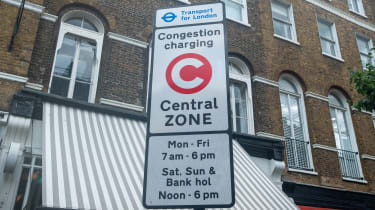
How the money is spent is another bone of contention. TfL’s most recent annual statement of accounts showed C-charge revenues for the full year increased from £316million in 2020/21 to £423m in 2021/22. These are intended to be reinvested in transport in London, but critics such as the FfDF argue that the high operational costs of the C-charge mean there are few significant benefits.
The fact that emissions have always been taken into account has been a constant source of irritation to some, who argue that this is not relevant to its principal aim, which is reducing traffic, particularly when a separate charging scheme, the ULEZ (Ultra-Low Emission Zone) is also in place.
Calderato argues they are very different, explaining: “If you do have to be there in central London during charging hours, we want it to be in as clean a vehicle as possible. For ULEZ, you don’t need to be in the greenest vehicle possible. You just need to be in one that meets the emission standards, which most vehicles do.”
She admits they are likely to be more intertwined when the C-charge marks its 40th anniversary in 2043. “In the very long term,” she says, "what we are looking at is having some kind of more sophisticated road-user charging rather than having a Congestion Charge, an Ultra-Low Emission Zone and a Low-Emission Zone [a scheme for large diesel vehicles across Greater London currently in operation]. We recognise that this kind of landscape is becoming increasingly complex.”
Consultations are already under way as to how this might work and what should be taken into account; distance driven, type of vehicle, time of day and other elements are all being considered. However the C-charge evolves, one thing that will not change is the feeling entertained by many motorists that they are being “discriminated against”, as the FfDF puts it. After 20 years, squaring that particular circle remains as far away as ever.
What's your view on the Congestion Charge? Join the debate in the comments...




